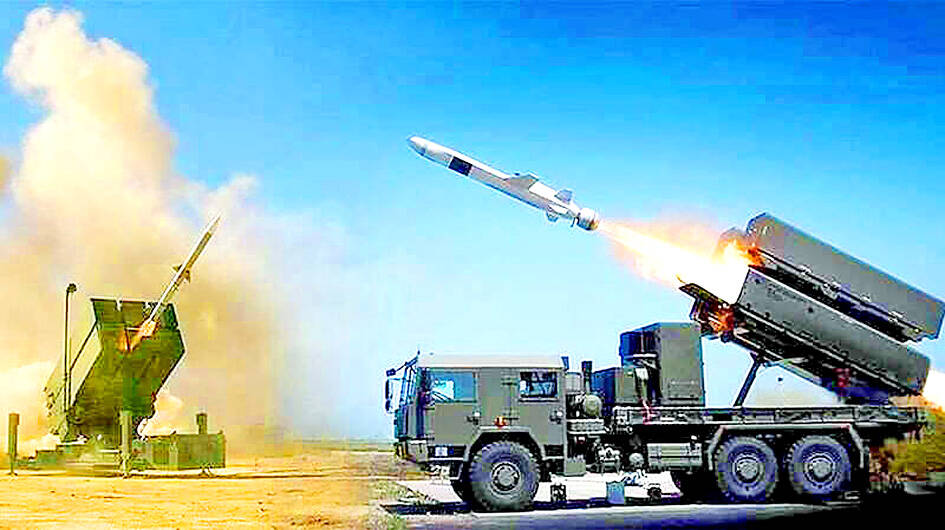Taiwan has signed a NT$24.99 billion (US$761 million) procurement contract with the US for three Norwegian Advanced Surface-to-Air Missile Systems (NASAMS) to aid air defense capabilities in northern Taiwan, the Ministry of National Defense said yesterday.
The contract was signed by the Defense Mission to the US and the American Institute in Taiwan, amounting to nearly NT$24.99 billion with a six-year time limit for contract performance that runs from Jan. 14 through Dec. 31, 2030, the ministry said in a statement published on the Government e-Procurement System yesterday.
The NASAMS would be delivered to Taipei’s Songshan District (松山) and New Taipei City’s Tamsui District (淡水), where they are expected to be deployed, it said.

Photo: screen grab from the Kongsberg Defence and Aerospace Web site
A source, who wished to remain anonymous, said that there is a chance of the first NASAMS being delivered by the end of this year.
The US Defense Security Cooperation Agency (DSCA) on Oct. 25 last year said that the US Department of State had approved three arms sales to Taiwan, including the NASAMS, an L-band AN/TPS-77 long-range radar system and an S-band AN/TPS-78 long-range radar system, which were initially projected to cost about NT$65.2 billion.
The ministry last month said that contracts for the three arms procurements would be signed and delivered by 2034.
The ministry signed four procurement contracts for NASAMS with the US which cost NT$49.3 billion, much less than the NT$65.2 billion estimated and announced by the US government, the source said.
The actual expenditure could be lower because it depends on raw material prices, production costs, order quantities and competing buyers, the source said.
As the ministry’s budget for NASAMS procurement remains classified for this fiscal year, the actual amount of the procurement would not be unveiled until the classified budget is disclosed next year, they said.
According to the DSCA, the new procurement of three NASAMS also included 123 AIM-120 advanced medium-range air-to-air missiles, which have a range of up to 50km.
The missiles would be deployed in Taipei and New Taipei City to complete the air defense capabilities in that area in addition to the Patriot Advanced Capability-3, Tien Kung (Sky Bow), Lu Chien II (Land Sword II) and AN/TWQ-1 Avenger missile systems.
The use of NASAMS would boost operational flexibility, as they are compatible with the ammunition employed by F-16 aircraft, including AIM-120 missiles and AIM-9X Block II Sidewinder missiles.

The US government has signed defense cooperation agreements with Japan and the Philippines to boost the deterrence capabilities of countries in the first island chain, a report by the National Security Bureau (NSB) showed. The main countries on the first island chain include the two nations and Taiwan. The bureau is to present the report at a meeting of the legislature’s Foreign Affairs and National Defense Committee tomorrow. The US military has deployed Typhon missile systems to Japan’s Yamaguchi Prefecture and Zambales province in the Philippines during their joint military exercises. It has also installed NMESIS anti-ship systems in Japan’s Okinawa

‘WIN-WIN’: The Philippines, and central and eastern European countries are important potential drone cooperation partners, Minister of Foreign Affairs Lin Chia-lung said Minister of Foreign Affairs Lin Chia-lung (林佳龍) in an interview published yesterday confirmed that there are joint ventures between Taiwan and Poland in the drone industry. Lin made the remark in an exclusive interview with the Chinese-language Liberty Times (the Taipei Times’ sister paper). The government-backed Taiwan Excellence Drone International Business Opportunities Alliance and the Polish Chamber of Unmanned Systems on Wednesday last week signed a memorandum of understanding in Poland to develop a “non-China” supply chain for drones and work together on key technologies. Asked if Taiwan prioritized Poland among central and eastern European countries in drone collaboration, Lin

Renewed border fighting between Thailand and Cambodia showed no signs of abating yesterday, leaving hundreds of thousands of displaced people in both countries living in strained conditions as more flooded into temporary shelters. Reporters on the Thai side of the border heard sounds of outgoing, indirect fire yesterday. About 400,000 people have been evacuated from affected areas in Thailand and about 700 schools closed while fighting was ongoing in four border provinces, said Thai Rear Admiral Surasant Kongsiri, a spokesman for the military. Cambodia evacuated more than 127,000 villagers and closed hundreds of schools, the Thai Ministry of Defense said. Thailand’s military announced that

CABINET APPROVAL: People seeking assisted reproduction must be assessed to determine whether they would be adequate parents, the planned changes say Proposed amendments to the Assisted Reproduction Act (人工生殖法) advanced yesterday by the Executive Yuan would grant married lesbian couples and single women access to legal assisted reproductive services. The proposed revisions are “based on the fundamental principle of respecting women’s reproductive autonomy,” Cabinet spokesperson Michelle Lee (李慧芝) quoted Vice Premier Cheng Li-chiun (鄭麗君), who presided over a Cabinet meeting earlier yesterday, as saying at the briefing. The draft amendment would be submitted to the legislature for review. The Ministry of Health and Welfare, which proposed the amendments, said that experts on children’s rights, gender equality, law and medicine attended cross-disciplinary meetings, adding that